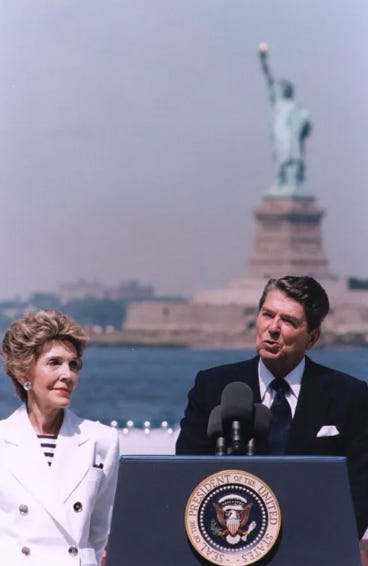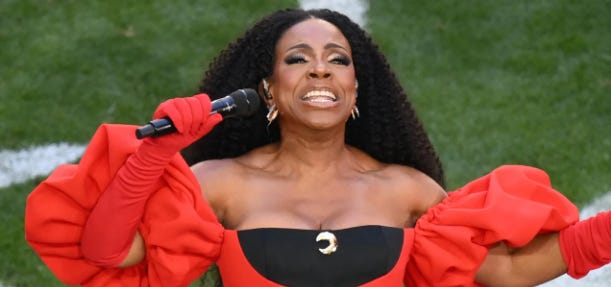I was reading Charlie Sykes’ Morning Shots Newsletter and he had an excerpt with Pulitzer Prize winning writer Anne Applebaum, discussing the Ukraine War one year after its start. Applebaum is always interesting and insightful, particularly on eastern European issues, but this portion stood out:
This is why Zelensky has been so successful around the world, and why he has such a deep appeal: He has combined, on the one hand, liberal values with, on the other hand, nationalism, or patriotism, or whatever you want to call it. What he does is a patriotic, nationalistic defense of liberal values. And that's why he can appeal to a wide part of the political spectrum, not just in the US, but all across Europe, because people can identify with that. And it's a thing that people have felt to be missing. And I think that's the source of it. And again, it also works because it's true.
You’re damn right.
Ever since the ‘60s with Vietnam, the left has been the party rejecting nationalism. People forget how quick a turnaround that was; it was only in the 1940s when Democrat FDR rallied the American public to fight wars in both Europe and the Pacific, opposed by a largely isolationist Republican party who wanted to stay out of both right up until Pearl Harbor was attacked. The Nationalism that FDR and Harry Truman enjoyed dissipated during the ‘50s (when Korea, the post-war Boom and McCarthyism co-opted much of it) and the 60s when liberals became disillusioned with the establishment. Ever since Nixon, it has been the right that drapes itself in the flag and promoted nationalistic values.
People don’t realize how unifying nationalism is to a country. These forces that pull and rip society apart culturally fade away when a country unifies toward a common goal, and uses the symbols of a united country to do it. Following the meh ‘70s and iffy early ‘80s, Reagan rode the nationalism train all the way to a 49 state sweep in 1984. “Morning in America,” celebrating patriotism, projecting national unity and strength, the 1984 Olympics (which was like nationalistic steroids) and providing a sense of optimism in the country helped the United States unite and feel good about the direction we were going as a nation. By the time he celebrated the Statue of Liberty’s 100th birthday in 1986, people were openly talking about getting rid of the 22nd Amendment so Reagan could run for a third term.1
Republican’s grip on the nationalist symbols were so strong that the image of being opposed to the GOP was seen as opposing America. It’s something that was used to great effect by George W. Bush after 9/11. Flags, lapel pins, yellow ribbons around trees, “support our troops,” all of it. It was so effective that when the US invaded Iraq in 2003, even with many then asking why and skeptical, Bush had a 75% approval rating. In the 2004 election, it was a constant theme of the Bush campaign that Kerry wasn’t patriotic because of his opposition to the now debacle of an Iraq War (even though Kerry served in Vietnam and won Purple Hearts) and that to oppose the war in Iraq was to oppose America. It worked, but barely so this time.
The Left’s Problem with Nationalism
Fast forward to 2010s. The hardcore right metastasized into the Tea Party, wearing tricorner hats, waving the Gadsden Flag2 ("Don't tread on me") and talking about revolutionary themes--can you think of anything less patriotic than revolting against it? In 2016, the Republican Presidential Candidate Donald Trump’s whole campaign theme was “Make America Great Again” as if America was no longer great.3 As President, he sought to get the United States out of international agreements and alliances, including NATO and the United Nations (both of which we set up to have the US near the top of the world order). He had no problem disparaging the US Military for past transgressions. He was such a pessimist that his whole schtick is to say "America Sucks" but not out loud. When he left office he tried to undo the Electoral College vote and may have started an insurrection against America! His supporters? They dress themselves in the flag but are more anxious to wave the "Trump/Pence" banner than "Old Glory." It has become the political right in the United States becoming anti-establishment and rejecting U.S. nationalism.
It seems that nationalism could easily be co-opted by the left and used to great effect at the moment. Biden has rallied the world order to fight against Putin in Ukraine, assist Zelensky and the Ukrainians and support militarily. The United States has also come out of the COVID pandemic economically much better than other major industrical countries. It seems like promoting United States Nationalism has not had a more ripe moment since 1980 and the Miracle on Ice.
So why hasn’t it? Well, there are a number of reasons, but the main one is a lack of unity even within it’s own party. Biden made it past the Democratic Primaries in 2020, but only barely so and most Dems would prefer to see someone else, even if Joe is number 2 on most lists. Biden’s age and the manner in which White House aides relatively shield him from the public projects a relative weakness. For nationalism to work well, you need a strong unifying leader.
Which brings up point two; the Democrats seem to support disunifying themes.
At the Super Bowl this past weekend, much was made of Sheryl Lee Ralph’s excellent rendition of “Lift Every Voice,” a song often promoted as the “Black National Anthem.” It’s a fine song and Ralph was incredible with it. However, offering an alternative anthem to a select group is by nature disunifying, much like trying to rally around two separate flags. Now, many have argued the current National Anthem, the “Star Spangled Banner” doesn’t speak to them either; fair enough, totally get it and even agree to an extent. It doesn’t change the fact that it is still currently the National Anthem and a powerful symbol of America.4 If you want to unify a group and bring people together, you can't have alternates, you have to stand behind one, as one.
But nothing represents the disunifying nature more than the evolution of the rainbow flag representing gay rights. At first, it was just a rainbow flag, representing everyone, meant to unify the LGBT community. But as the idea of what it meant to be LGBT evolved (to currently LGBTQIA+ and....), the additional “groups” under this banner required their own color stripe for representation (it should be noted that before this, the “stripes” didn’t reflect any one group, only that they were “everyone” part of the whole spectrum), so additional stripes not of the original spectrum were added. Lately, more groups wanted representation on the flag adding even more symbols. The current flag with the most acceptance right now is this one5:
Within the Gay Rights community there are currently over 40 different identity subgroups, each with their own flag. For unity to work, there has to be a level of subordination individuals and subgroups are willing to unify behind. When every subordinate person/group requires an individual level of expression to the point that the group can only be represented by something that looks like a corporate brainstorming sessions spewed out, there is no overall unity, just varying groups in a standoffish semi alliance.
Which perfectly describes Democrats when you think of it. There is no universality to the Democratic Party at the moment; its a loose knit organization of various identity groups in a relative alliance for mutual benefit, each wanting to put their own stamp on the group as a whole rather than work within its current structures to broaden its appeal. The nature of the party organization is more to work to appeal to these core groups to keep them in line rather than appeal to America as a whole and general themes that unite; pluralism, economic and social fairness, sound government, national defense, community.
Lastly, there is regionalism that Democrats don’t seem willing to overcome or appeal to. To unify the country with nationalism, you have to appeal to the whole nation. Even though Democrats have won races in Kansas, Montana and Texas at the grassroots level, Democrats seem unwilling or shift focus from appealing to base groups over to a more generalized mission. Instead, they’ve maintained focus on coastal areas or cosmopolitan metros and the uber-liberal MSNBC voters they feel comfortable with. To create a national groundswell, they have to get out into the nation, work at the grassroots, travel to rural america and make their cases. You have to inspire everyone toward a common purpose.
Conclusion
So there is this patriotism vacuum just sitting there for the taking of the right candidate appealing to the right themes. That appeal would stretch far and wide across the country and a landslide in 2024 is not out of the question, just in time for America’s 250th Birthday in 2026.
The country would be much better off if a more liberal nationalism would take foot, but unfortunately, the left in America seems more interested in remaining fragmented and use their own symbols rather than rally behind a common one and demonstrate strength an unity.
PurpleAmerica’s Recommended Stories
The Charlie Sykes article I reference can be found here:
Anne Applebaum is an outstanding writer with a great perspective. She’s featured regularly in the Atlantic and Washington Post and has written several books, the ones of which I’ve read were outstanding. Highly recommend. Here is her personal webpage.
https://www.anneapplebaum.com/
PurpleAmerica’s Obscure Fact of the Day
People genuinely want to feel proud of our country. They want to show patriotism, and its been something we’ve been without for a long time. How bad is it?
Last year, Gallup polled the lowest feeling of patriotism in its history when the week before Independence Day 2022, only 39% were found to be proud of their country.
Let’s work to turn this around.
PurpleAmerica Cultural Criticism Corner
As mentioned in the main story, I’m not particularly in love with the Star Spangled Banner as a National Anthem, and would like to hear your suggestions for replacements. My top three?
Living in America by James Brown. How can you not like the Godfather in Soul from the most Cold War Nationalist Rocky film of the 1980s, dancing with Apollo Creed? Iconic. Just try and picture your 8 year old at school doing this at an assembly.
This Land is Your Land by Woody Guthrie. As great as it is though, this satire from the 2004 election to the tune of it is still the best electoral gem of the past 20 years.
Coming to America by Neil Diamond. There is absolutely zero chance of it actually becoming the Anthem though since it focuses on immigrants and the immigrant experience, and one party really hates that.
Footnotes and Parting Thoughts
Let me know what you think of the page. Please share and comment!
It was not disclosed until well after his second term ended, but by 1988 the Gipper was already experiencing the effects of Alzheimers.
Seriously, I wanted any Democrat to just say straight to Trump, “America is great, asshole.”
I am not really a fan of the Star Spangled Banner myself but acknowledge it as an anthem. Musically, its distinct, and people learning instruments learn how to play it early. Frankly, I’d prefer a different anthem myself but that would require a 180 degree change in attitudes to most americans, and its a fight on a hill not worth dying on.
What it represents aside, this is just an ungodly eyesore of color.









